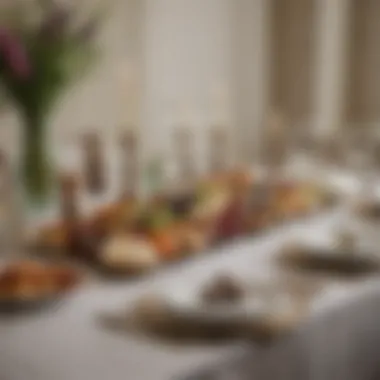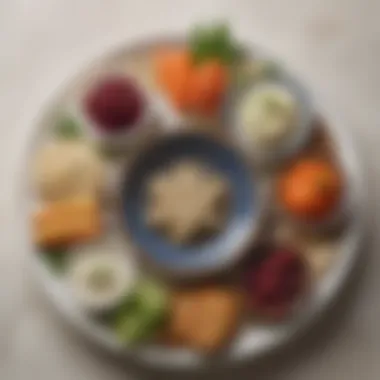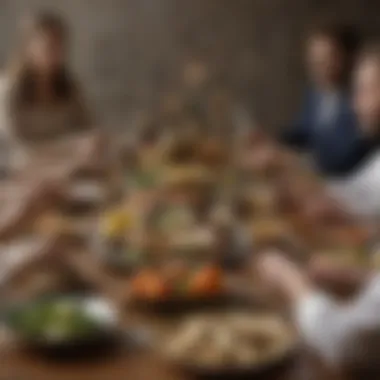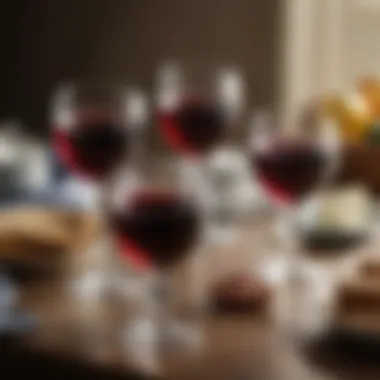How to Host a Seder: A Step-by-Step Guide for All Levels


Intro
Hosting a Seder is an essential part of the Jewish Passover celebration. It represents a rich tapestry of rituals, prayers, and symbolic foods, which unite family and friends in remembering the exodus from Egypt. There is much depth to this tradition, and understanding its nuances is crucial for any host. This guide offers a detailed roadmap to create a respectful and joyous Seder experience for everyone.
The success of a Seder often hinges on its structure and flow. It is important to prepare in advance and understand the significance of each component. Hosts may be veterans of Seder organizing, or they may be venturing into new territory. Regardless of one's experience level, the instructions provided here will ensure that every guest walks away with a genuine appreciation for this poignant observation of faith, history, and community.
Recipe Highlight
An appealing recipe for anyone interested in sharing a part of the Seder meal is Charoset, a traditional sweet mixture often used during the Seder. This dish symbolizes the mortar that the Jewish slaves used while building in Egypt.
Essential Ingredients
- 2 cups of diced apples (preferably Granny Smith)
- 1 cup of walnuts, chopped coarsely
- 1 teaspoon of cinnamon
- ½ cup of sweet red wine such as Manischewitz
- 1 tablespoon of honey (optional)
Estimated Time
Preparing Charoset typically takes about 15-20 minutes.
Servings
This recipe generally yields about 6-8 servings, depending on the portion size.
Step-by-Step Instructions
- Begin by washing and peeling the apples. Dice them into small pieces to allow for easier mixing.
- Place the diced apples in a large mixing bowl, followed by the chopped walnuts.
- Add the cinnamon and mix gently to distribute it evenly.
- Pour in the sweet red wine. Stir the mixture well.
- Taste for sweetness; if desired, add honey and mix again.
- Refrigerate for at least one hour before serving to allow flavors to meld together.
Ensure that the walnuts are not overly crushed, as you need a texture that complements the apples. Avoid preparing Charoset too far in advance, as the apples can brown.
Variations and Substitutions
Individuals can custom-create their Charoset by using different fruits or nuts.
- Alternative Ingredients: Pears, figs, or other dried fruit can replace apples. Almonds or pecans might also be substituted for walnuts.
- Extra Flavor: Incorporate citrus zest for brightness or a dash of vanilla extract.
- Pairing Suggestions: Serve Charoset alongside matzah for a delightful flavor combination.
Time-Saving Cooking Tips
Efficiently preparing ingredients can ease the cooking task.
- Pre-cut the apples or nuts a day before if busy on the Seder night.
- Utilize a food processor to chop ingredients quickly; however, be careful to avoid pureeing the mixture.
- If you plan multiple meals, you can make a larger batch of Charoset and enjoy it throughout the week on toast or in salads.
Nutritional Information
Charoset offers a nutritious addition to your Seder meal. Approximately one serving contains:


- Calorie Count: 180 calories
- Key Nutrients: 2g of protein, 8g of sugar, 3g of fiber
It holds well within various dietary frameworks, being naturally gluten-free and suitable for vegan diets as well.
“Charoset embodies our history as much as our food. Fertile flavors, mixing ages and meanings.”
This detailed exploration highlights the significance of the Seder, showcasing key aspects one should consider. With ample understanding and preparation, you can create a memorable Seder steeped in tradition.
Prelims to Seder
The Seder represents a fundamental tradition within the Jewish Passover celebration. This ritual serves not only as a meal but as an educational moment. Each Seder commemorates the exodus of the Israelites from Egypt, fostering a sense of cultural identity while connecting generations through shared history and customs. Incorporating unique practices, prayers, and symbolic foods, hosting a Seder can be a profound experience for both the host and the guests. Understanding the structure and meaning behind its elements is essential for creating a truly engaging event.
Understanding the Significance of Seder
The act of hosting a Seder is deeply meaningful. It invites participants to explore the themes of freedom, gratitude, and hope. Each item on the Seder plate has intrinsic meaning tied to the Parssover story that might inspire conversation and reflection. It provides a suitable backdrop for imparting values to younger guests, enhancing their connection to cultural heritage. Furthermore, the communal aspect serves to strengthen relationships among family members and friends, reinforcing the bonds that unite them.
"The Seder invites us all to engage with our past while contemplating our future."
Historical Context
The origins of the Seder can be traced back thousands of years to the biblical accounts of the Israelites in Egypt. These stories highlight the struggles they faced, serving as pivotal moments in Jewish history. The tradition of the Seder provides modern-day Jews a way to commemorate this significant time with purpose. Over centuries, customs have evolved, adapting folklore and regional flavors into modern celebrations.
Understanding the historical context of the Seder components enhances one's appreciation of the event, revealing its layers of meaning intertwined with historical events. Consequently, each Seder becomes not merely a traditional meal but a comprehensive narrative of identity, resilience, and faith in future freedom.
Basic Components of the Seder
The Seder is a multifaceted event rich with rituals and traditions. Understanding the basic components of the Seder is essential for effective hosting and meaningful participation. These components are not just ceremonial, but they also educate and deeply connect participants to Jewish history, faith, and identity.
Essential Rituals
Rituals are at the heart of the Seder experience. Each ritual serves a significant role in the celebration of Passover, dictating what happens during the evening and ensuring that tradition is maintained. From the lighting of candles to the ceremonial washing of hands, every act is laden with symbolism and meaning. Arranging these rituals in a coherent manner allows both hosts and guests to familiarize themselves with the customs and maintain the Seder's integrity.
Symbolic Foods
The symbolic foods represent historical elements of the Jewish people's exodus from slavery. Each offering speaks to a unique aspect of the journey and carries theological weight. Some pertinent components include:
- Maror (Bitter Herbs): This component stands for the bitterness of slavery faced by the Israelites in Egypt. The stark taste of Maror, usually made from horseradish, is memorable. It reinforces the experience of liberation. Just as bitterness can evoke discomfort, it reminds participants of past suffering and the importance of resilience. As a popular choice, it can hit home with the emotions invoked during the Seder night.
- Charoset: This delightful mixture typically consists of apples, nuts, spices, and wine. Charoset reflects the mortar used by the Israelites in their labor. It offers a sweet contrast to Maror, signifying hope and sweetness emerging from hardship. It enriches the table and creates conversation among guests, allowing all to express personal memories associated with family traditions regarding its preparation and variation.
- Karpas: Often made from parsley or celery dipped in salt water, Karpas symbolizes springtime and renewal. Serving on the Seder plate, it represents hope of freedom. Additionally, the dipping ritual also encourages participation and discussion amongst guests. Such interaction makes this a thought-provoking component within the entire event.
Four Cups of Wine
The ritual of drinking four cups of wine during the Seder commemorates the four expressions of redemption found in the Torah. This act generates ritualistic joy and connectivity to the experience of liberation. Each cup symbolizes a verse highlighting God’s promise of redemption.
Engaging with the wine adds Social value, foosterialization opportunities for personal storytelling or collective reflection on the deeper meaning of freedom and tradition. Availability and quality of wines can also dictate your hope that this created ritual may carry both nostalgia and expectation.


In summary, observing these basic elements during the Seder is vital. Not only do they provide structure to the event, but they also ensure that deeper values and lessons of collective memory are effectively conveyed. The interactions spurred by the symbolic foods and essential rituals contribute to communal bonding, leaving an indelible mark on all participants.
Preparing for the Seder
Preparing for the Seder is a crucial part of the overall experience. It involves creating an inviting atmosphere and ensuring that every element is well thought out. This preparation not only honors the tradition but also allows participants to engage deeply with its significance. Each detail matters. It helps in creating a cohesive experience that resonates with the stories being shared during the Seder.
Creating a Seder Plate
The Seder plate holds great symbolic importance. It typically includes six items, each representing an aspect of the Exodus story or a significant element of the Passover narrative. Traditionally, items on the plate include lamb shank bone, maror (bitter herbs), charoset, fish, karpas and an egg. The way they are arranged can reflect personal or family traditions, making it a unique expression of history. Having a beautifully arranged Seder plate contributes to the visual and spiritual aspects of the evening.
Choosing the Right Haggadah
Selecting the appropriate Haggadah is essential for the flow of the Seder. The Haggadah outlines the rituals, blessings, and prayers that guide the evening. It can reflect various interpretations and levels of scholarship. Different families may have their own custom Haggadot that incorporates family histories and personal stories. Ensuring that your choice accommodates all ages and levels of understanding is crucial. It can spark discussions and facilitate a deeper connection with the themes presented.
Setting the Table
Setting the table for the Seder involves careful attention to detail. A meticulously set table can elevate the spirit of the event. It is more than just functionality; it symbolizes the fundamental aspects of hospitality, honoring guests and tradition alike.
Tablecloth and Utensils
Choosing the right tablecloth and utensils adds to the formal nature of the Seder. A white tablecloth is often chosen to symbolize purity. Using elegant dinnerware enhances the occasion, aligning with principles of beauty and respect. The materials can be simple yet elegant. Choosing stainless steel vs. gold utensils could reflect taste and cultural implications. Even small details like the type of glasses for wine can affect the overall sense of elegance and tradition.
Candles
Candles play a significant role in setting the atmosphere. Lighting candles at the beginning of the Seder signifies the onset of the holiday and the call to sanctify the day. The flame itself symbolizes brightness and joy. The use of special holiday candles, such as those made of beeswax, can add to the tradition. Keep in mind the placement of candles on the table to ensure they are safe but also visible. Their warm light contributes to a feeling of sacredness throughout the evening.
Thoughtful preparation not only respects traditions but also enhances the collective experience.
Conducting the Seder
Conducting the Seder is a central piece of the Passover celebration. It merges tradition, education, and community. During this ritual, participants engage in a structured discourse that enables them to relish the significance of Passover deeply. This engagement emphasizes historical understanding and collective memory, making the Seder much more than just a meal.
Opening the Seder
The opening of the Seder marks the commencement of a powerful journey through memory and tradition. It typically begins with the lighting of candles, which represents welcoming the joy and sanctity of the holiday. The leader recites a blessing, instilling a sense of reverence for the evening ahead. The first cup of wine follows, creating an atmosphere conducive to operating the remaining rituals with gravity and joy.
Additionally, announcing the themes of freedom and liberation establishes a solemn tone. It’s an opportunity to gather everyone’s attention and emphasize why this evening matters to the Jewish community.
Reciting the Haggadah
The Haggadah serves as both a guide and a narrative for the Seder, ensuring each participant is aware of their role. It translates centuries-old traditions into a contemporary context, allowing even those unfamiliar with the rites to participate meaningfully. The structure outlines key phases, such as the symbolic acts and readings.
Each part of the Haggadah elucidates a story. As sections unfold, the gentle melody coupled with the tale being recounted, reinforces the bond among participants. The act of reciting together fosters communal identity and historical continuity. Each reading contributes essential understanding, instilling appreciation for heritage.


Interactive Elements
Questions and Discussions
Questions and discussions constitute vital elements of the Seder process. They endorse active engagement amongst participants. This facet promotes curiosity and dialogue, encouraging everyone to think critically about the themes presented. Calling on individuals to ask questions transforms passive listeners into active participants.
A unique characteristic of this segment is its ability to facilitate personal reflections based on shared experiences. Questions may cover historical events or moral dilemmas, keeping the conversation multifaceted and captivating. Participants feel more involved, and their voices amplify the significance of the Seder as they express their thoughts and queries. The advantage here lies in the communal dynamism—each person shapes the experience, contributing various viewpoints, enriching the discussion repertoire.
Songs and Readings
Songs and readings form another essential part of the experience. They uplift the spirit and add a melodic context to the evening. Many harmonic selections arise from centuries of Jewish cultural heritage, giving both young and old a platform to echo communal memory through rhythm.
The collective singing not only varies the tone of the Seder, but it often paves way for emotional connections that words alone might fail to encapsulate. This invites a lighter atmosphere, offering cohesion through jubilant expressions. However, a disadvantage may arise if participants are uncomfortable with singing or reading aloud, potentially creating division. It is crucial to encourage participation in ways that resonate with everyone, ensuring inclusivity while recognizing this moment's solemn essence.
In summary, conducting the Seder efficiently intertwines participation, history, and shared identity. The interactive facets allow flexibility and adaptability, indispensable for maintaining the integrity and significance of this beautiful tradition.
After the Seder
Understanding what happens after the Seder is essential, as this point reflects on the significance of engagement, hospitality, and continuity in cultural practice. The concluding moments of the Seder extend beyond the rituals into familial bonds and personal reflections. It is important to consider both the emotional and practical actions needed to wrap up this meaningful event in a way that honors traditions while allowing for a modern exchange of ideas and epochs.
Reflections and Family Discussions
After the Seder, it is beneficial for guests and family members to engage in discussions about what they experienced during the ritual. This reflection can deepen emotional resonance and enhance understanding. Families can share personal stories related to the holiday or discuss insights gleaned from various passages read during the Haggadah. This dialogue not only fosters a stronger family connection but also solidifies the importance of the Seder traditions.
The atmosphere after a traditional meal tends to support a relaxed exchange of thoughts. Individuals can take the opportunity to speak about how these themes resonate in contemporary society. What did the experience of liberation symbolize for each guest?
Some reflective questions might include:
- What was your favorite part of the Seder?
- Did any reading particularly resonate with you this year?
- How do you relate the story of Passover to current societal themes?
Storing Leftovers
Once the conversations and reflections have taken place, practical matters arise, particularly regarding the food that remains. Efficiently storing leftovers is vital not just for minimizing waste but also for ensuring that the quality of the food is preserved. This practice further continues the traditions surrounding the holiday by allowing family members to continue tasting the symbolic foods.
It is beneficial to follow a systematic approach when storing leftovers:
- Separate Symbolic from Non-Symbolic Foods: Keep maror and charoset in distinct containers to maintain their characteristics.
- Use Airtight Containers: This minimizes exposure to air. It is better for the flavor and freshness of the food.
- Label Containers: Write the date on which the food was stored for rotation. This practice ensures you use these items within a safe timeframe.
- Refrigerate Promptly: To maintain food safety, it is essential to place leftovers in the refrigerator within a specific time.
By taking the time to reflect and carefully manage leftovers, the Seder extends itself beyond a single night. Engaging in dialogue helps reinforce family and community values, while effective food storage serves practical and symbolic needs.
Finale
Hosting a Seder holds significant importance, both as a ritual and as a moment to connect with family and history. This gathering serves as a powerful reminder of the themes of freedom, faith, and continuity. Having a clear understanding of how to conduct the ceremony helps bring alive the stories of the past, making them relevant for today's gathering
Embracing Tradition contributes to the collective memory of a community working to keep alive its values and teachings. Making deliberate choices—be it in the symbolism on the Seder plate or the readings chosen for the Haggadah—helps participants engage more fully. It can opne dialogue that encourages reflection on contemporary issues through the lens of traditional teachings.
Benefits extend beyond just the ritual itself. A well-organized Seder can strengthen bonds among participants, foster understanding of cultural heritage, and deepen empathy as stories unfold around the table. Those hosting for the first time can also learn and grow by being involved in traditions that have spanned generations.
Considerations such as dietary needs of guests, interests, and family dynamics can have a lasting potential to shape the experience. The evening acts as a framework to discuss and celebrate what has been learned and the opprtunities for learning yet to come.
As you conclude your Seder, the intention should be to create lasting memories that resonate with everyone present—memories that keep the flames of tradition alive for future generations. Remember to support one another as you continue making these stories part of your contemporary life.







